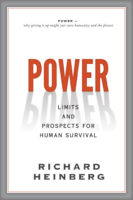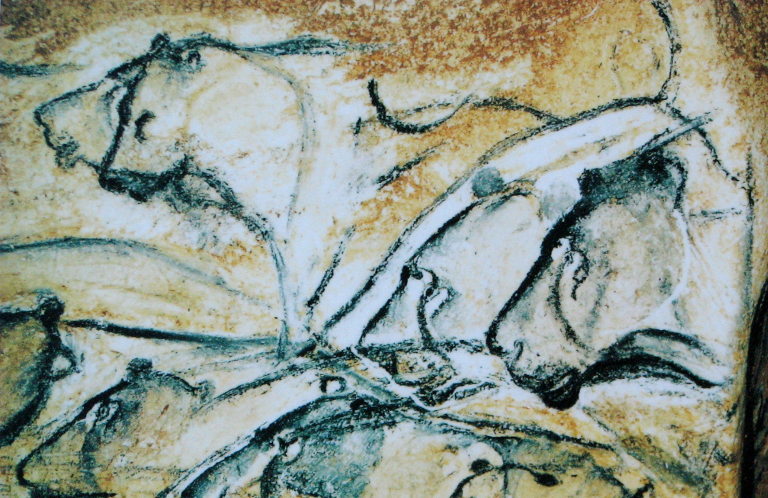 This is an abridged excerpt from Power: Limits and Prospects for Human Survival (2021) by Richard Heinberg; posted with permission from New Society Publishers.
This is an abridged excerpt from Power: Limits and Prospects for Human Survival (2021) by Richard Heinberg; posted with permission from New Society Publishers.Read more in this series.
The Power of Art
Humans began making art and music early in their evolutionary journey. Cave paintings and bone flutes started appearing roughly 40,000 years ago—about the same time as language and stone tools likely took a leap forward. Paleolithic paintings of animals and humans are exquisite and expressive. Ancient flutes, made from mammoth and vulture bones, produce tones with the same tonal relationships (whole tones, half tones) as the tones produced by modern musical instruments like the piano or guitar. We also see evidence of body art and decoration around that time. Moreover, as soon as we had language, we probably started using it playfully and creatively to make songs, poems, sagas—and jokes. Little of this had to do with survival needs. Music, art, and wordplay implied a power not of domination, but of shared celebration and transcendence.
It’s common to speak of the power of a work of art—a painting, a musical performance, a dance, a play, or a piece of literature. But what kind of power is this? It’s a different kind than those we have addressed so far, and to ignore it would be to overlook an essential aspect not just of humanity, but of nature itself. The evolution of life via the maximum power principle [discussed in the Introduction] seems straightforward: those organisms that are able to harness and exert more power leave behind more offspring and displace other organisms. Viewed this way, life appears grimly competitive. Yet, when we look at the result of billions of years of evolution, it’s amazingly beautiful.
As we saw in Chapter 1, animals and plants devote enormous effort toward creating beauty as part of reproduction. And, as we have just seen, aesthetic preferences have, via sexual selection, also likely sculpted the human body and altered our instinctive behavior. With sexual selection, evolution was no longer tied just to fitness.
Once beauty assumes a priority, it often becomes an end in itself. Though it may begin with courtship displays, beauty can take on a significance of its own. Birds appear often to sing for pure pleasure, even when there’s no need to attract a mate. With humans, as cultural evolution accelerated, our quest for beauty also became largely detached from sexual selection. Aesthetic appreciation and the production of beauty co-evolved ever more quickly to become overwhelming obsessions.
The result, today, is that we live in an aesthetic human world. Nearly every surface in a modern city is designed. Cars, houses, office buildings, and tools of all kinds—from motorcycles to fountain pens—have become canvases for the creative process. And we are immersed in entertainment of every imaginable variety—from background music to novels to television dramas. The typical modern human “consumes” art almost from the moment they wake up till the moment they fall asleep at night.
The obsessiveness with which we pursue artistic production and appreciation can be illustrated by one activity to which (for better or worse) I have devoted tens of thousands of hours: playing the violin. Try watching and hearing violinist Hilary Hahn perform Paganini’s 24th Caprice on YouTube. A dozen or more notes may fly by each second, each perfectly in tune, and each perfect also in articulation and tone color. Hahn’s two hands are engaged in entirely different tasks that must somehow be exactly synchronized. And the point of the exercise isn’t just to make no mistakes while doing several nearly impossible things simultaneously, but to confidently create beautiful and moving music. With all due respect to brain surgery, I can say with some assurance that no activity by a human or any other animal requires as much digital precision as top-level fiddling does. And it’s not just the violinist’s fingers that are involved, but the wrists, arms, and back muscles—and, first and foremost, the brain. Finger exercises…are useless without a trained “ear”—which really means a highly trained brain—that can recognize tiny variations in pitch and rhythm, and make nearly instantaneous corrections on the fly.
This digression underscores a point I’ve already made: that the dexterity of the human hand cannot be explained solely by anatomical factors. The evolution of violin playing, and of tool use in general, took place on many levels—anatomical, mental, social, and aesthetic—more or less simultaneously.
However, my example primarily illustrates many humans’ utter devotion to aesthetics, to a degree that is difficult to justify in terms of either natural selection or sexual selection. Yes, many young men buy a Stratocaster and take guitar lessons in order to impress the girls. But I find it difficult to imagine that such a motive would compel a five-year-old child to begin practicing a supremely difficult musical instrument several hours a day and to continue doing so all through adulthood… The sports lover will recognize a similar obsession. Devotees of soccer, surfing, and sumo exhibit a similar level of compulsion, and the subjective experience of an outstanding performance in any sport can be described as aesthetic. Commitment to athletics can perhaps more readily be explained in terms of competition, selection, and fitness (and the financial rewards for professional-level performance are sometimes astronomical), but the pursuit of excellence in sports and the arts is, in both cases, quasi-spiritual.
Evolution gave us power over the natural world. But in doing so it gave us abilities that could be used for things that had little or nothing to do with power in the conventional evolutionary sense—i.e., the ability to get food or find a mate. The power to communicate aesthetic pleasure and thereby to feel profound affinity with other people, including individuals of other species (as we do when we enjoy the beauty of birdsong or thrill to the sight of a pod of dolphins “dancing” in perfect synchrony through the waves, to cite just two possible examples), propel human culture forward in ways that are hard to measure, but that are impossible to ignore. These are powers that, as we’ll see later in this book, provide hope for our future.
Read more in this series.
Teaser photo credit: (Replica of) cave lion drawings from Chauvet Cave in Southern France from the Aurignacian period (c. 35,000 to 30,000 years old). By HTO – Self-photographed, Public Domain, via Wikimedia Commons.





